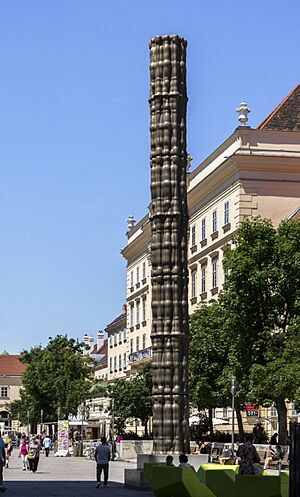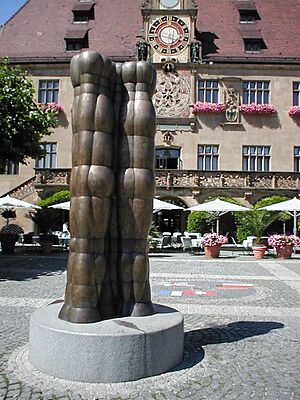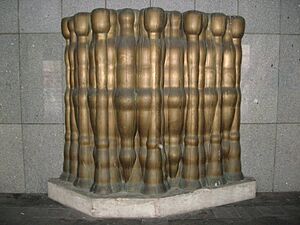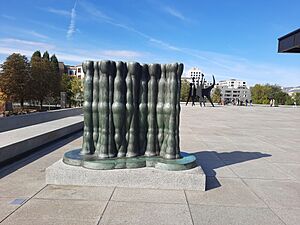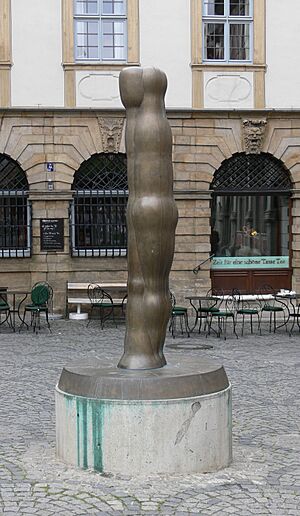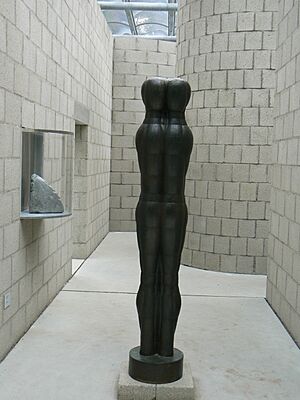Joannis Avramidis facts for kids
Joannis Avramidis (Greek: Iωάννης Aβραμίδης) was a famous Greek-Austrian artist who created sculptures and paintings. He was born on September 23, 1922, in Batumi, a city by the Black Sea in what is now Georgia. His family were Pontic Greeks who had left the Ottoman Empire to escape difficult times. Joannis Avramidis passed away on January 16, 2016, in Vienna, Austria, at the age of 93.
Contents
His Life and Journey
Joannis Avramidis started studying painting in 1937 at the State Art School in Batumi. But his studies stopped early in 1939 when his family had to move again, this time to Greece. They faced tough times there. In 1943, when he was 21, he was sent to Vienna, Austria, to work in a train repair shop during World War II.
After the war ended, Avramidis was sent to a camp near Budapest because he knew Russian. But he managed to escape and returned to Vienna.
In Vienna, he started studying painting again at the Academy of Fine Arts from 1945 to 1949. A few years later, in 1953, a famous sculptor named Fritz Wotruba discovered Avramidis's talent for sculpture. This led Avramidis to study sculpture with Wotruba at the same academy from 1953 to 1956. After he finished, he received his first award, the Staatspreis der Akademie der Bildenden Künste in Wien.
«Wotruba was a stroke of luck for me, even though I wasn't really interested in him as a teacher at first. I had already left the academy. But then I came to the academy with a head sculpture, and Wotruba immediately called all his students to see it.»
Years later, he returned to the Academy of Fine Arts in Vienna, this time as a professor. He taught there from 1968 until he retired in 1992. He also taught for a year in Hamburg, Germany.
In 1962, Avramidis met another famous sculptor, Alberto Giacometti, at an art show in Venice. Giacometti admired Avramidis's sculptures, calling them "quality and drama."
Avramidis also showed his art at important exhibitions like documenta III (1964) and documenta 6 (1977) in Kassel, Germany. He had many solo and group shows throughout his life.
His Family Life
Joannis Avramidis's father, Konstantin, was a merchant and flower grower. His family had lived in Georgia for many generations. Joannis had three younger brothers and sisters. His brother Thomas often helped him make his sculptures.
In 1952, Avramidis married Waltraud Rathofer, but they divorced in 1955. That same year, he officially became an Austrian citizen. In 1962, he married Annemarie Avramidis, who was also an artist. They had a daughter, Julia Frank-Avramidis, who is now a painter too.
After his wife Annemarie passed away in 2014, Joannis Avramidis stopped appearing in public. He died on January 16, 2016, in Vienna, at the age of 93, surrounded by his family.
How His Art Developed
Starting as a Painter
When Avramidis first studied painting (1945-1949), he learned about early Renaissance painters like Masaccio. He painted small landscapes and quiet, thoughtful scenes. His teacher taught him how important it was to arrange things in a painting and to use simple, natural colors.
In 1948, Avramidis created his first "Cubic Heads" using charcoal. After finishing his painting studies in 1949, he continued to learn about art conservation.
Becoming a Sculptor
In 1953, Avramidis made his very first sculpture, a "Head," from stone. He showed it to Fritz Wotruba, who was very impressed. Wotruba invited Avramidis to join his sculpture class and even gave him a special studio to work in.
Avramidis's early sculptures, like "Small Half-Figure" (1954), still showed Wotruba's influence, using blocky, geometric shapes. But soon, Avramidis started developing his own unique style. He began to create figures that looked like they were made from many different angles, carefully put together.
After graduating in 1956, Avramidis focused on creating the "absolute figure." This meant he wanted his sculptures to represent the perfect human form, inspired by ancient Greek and Italian Renaissance art. His sculptures often blend abstract and realistic shapes. They have soft, rounded curves that suggest a human body without showing every detail.
«I would like my work to be as timeless as possible. My ideal vision is that I could have made my work in a different era as well, for example in the early Renaissance or the ancient archaic period.»
In 1957, Avramidis had his first solo art show. Around this time, he also started making sketches for sculptures based on math, like his bronze "Leg."
Figures and Column Figures
In 1958, Avramidis created "Large Figure," which was the first sculpture where he shaped the body like a column, with limbs and body joined together. This became his special style. He would make these "Figuren" (Figures) very simple and basic. From single figures, he moved on to "Figurengruppen" (Groups of Figures), where several figures were tightly joined into one block. These groups always had an odd number of figures. Avramidis's figures are often faceless, still, and serious.
In 1963, Avramidis made a sculpture called "Columns." He also created "Model for a Column II," which showed how he could stack figures, one on top of the other, to create a tall, mirrored column. This idea later led to his most important work, the "Column of Humanity," which was influenced by Constantin Brâncuși's "Endless Column."
City, Temple, and Market
In the mid-1960s, Avramidis started working on "Polis" (meaning "city" in Greek), which was a new way of grouping his figures. He also began sketching ideas for a "Tempel" (Temple), a big project he worked on throughout his life but never fully built. These ideas, along with "Agora" (meaning "marketplace"), came from his childhood experiences in Athens, where he saw the impressive ruins of ancient Greece. These experiences helped him connect with his Greek heritage.
Band Figures
In 1966, Avramidis started making a new type of sculpture called "Band Figures." Unlike his solid "Column Figures," these were more open and seemed to move. They often looked like rectangular, edged, or rounded bands. Examples include "The Walker" and "Seated Band Figure." An art historian noted that these figures were "centrifugal," meaning they seemed to spread outwards, looking for openness and movement in space.
Head Sculptures
A common theme in Avramidis's art was the human head. He often made them very stylized and abstract. Like Brâncuși, he simplified heads, sometimes even more so.
Many of his head sculptures don't have clear eyes, mouths, noses, or ears. Instead, they are smooth, rounded shapes that look like a skull on a strong neck. Sometimes you can see a hint of a chin or hair. Examples include "Head 2" and "Head IV" from 1959.
Some interesting works, like "Head IV [3 Stages]" (1959), show how he built a head in three steps: first a metal frame, then the frame filled with plaster, and finally, a bronze version.
"Head - The Trojan Horse" (1970) was different because it used orange synthetic resin over a metal frame. He also made a bronze version of this shape.
His "Large Head" (1970) is a big bronze sculpture that shows his focus on balance and proportion. This one actually has a clear nose, mouth, and a hint of eyes.
Later, he also made "Rectangular Figure" or "Band Figure" heads, like "Head Front Side (Rectangular Head)" (1968) made of aluminum.
Tree and Man-Tree
Another theme Avramidis explored was "Trees" and "Man-Trees," where he showed humans transforming into trees in his bronze sculptures.
Always a Painter
While Avramidis was famous for his sculptures, he also painted throughout his life. He never showed his paintings to the public while he was alive. Only after he passed away did many of his paintings come to light. A 2022 art show revealed these paintings, giving a new understanding of his complete work.
Some of his paintings, with earthy reds or steely blues, help us understand his sculptures better. Other paintings show portraits of his friends, like the poet Klaus Demus. He also drew portraits of himself and his brother.
From the 1980s, Avramidis painted unusual color studies called "Suns." These were abstract circles of pure color, often on a white background. It's a bit of a mystery why he made these colorful studies when his sculptures usually didn't have color.
He even painted landscapes from memory, like the places he walked in Vienna. These paintings were a return to more realistic art, showing that he never stopped being a painter, even as his sculptures brought him fame. Painting and drawing were quick and natural for him, while sculpting required a lot of thought and planning, almost like architecture.
Famous Students
Some Austrian sculptors who studied with Professor Avramidis at the Academy include Reinhard Puch and Wolfgang Götzinger.
Awards and Honors
Joannis Avramidis received many awards for his art throughout his life:
- 1956: State Prize of the Academy of Fine Arts in Vienna
- 1958: Austrian promotion prize for sculpture
- 1961: Award from the City of Vienna
- 1964: City of Vienna Prize for Visual Arts
- 1968: Will Grohmann-Prize (City of Berlin)
- 1973: Grand Austrian State Prize for Visual Arts
«Avramidis is not only "the" talent of his generation in Austria, he is certainly also "the" talent of his generation in Germany, and he is one of the few great sculptors of our time.»
- 1985: Austrian Decoration for Science and Art
- 1998: Elected Member of the Academy of Athens
- 2013: Grand Decoration of Honour in Gold with Star for Services to the Republic of Austria
Exhibitions
Joannis Avramidis's work was shown in many exhibitions around the world. Here are some notable ones:
- 1956: The 28th Venice Biennale, Italy.
- 1957: Galerie Würthle, Vienna, Austria.
- 1962: The 31st Venice Biennale, Italy.
- 1964: Documenta, Kassel, Germany.
- 1967: Kestner-Gesellschaft, Hanover, Germany.
- 1977: Documenta, Kassel, Germany.
- 1979: 3rd Biennale of Sydney, Australia.
- 1997: Retrospective exhibition at the National Gallery of Greece in Athens, where he donated many of his works.
- 1999: Joannis Avramidis. Köpfe (Heads), Galerie Thomas, Munich, Germany.
- 2012: Joannis Avramidis. Körper & Struktur (Body & Structure), celebrating his 90th birthday at the Kunsthistorisches Museum, Vienna, Austria.
- 2017: Retrospective at the Leopold Museum, Vienna, Austria. For this show, his tall "Humanitas-Säule" (Column of Humanity) was put up in the MuseumsQuartier.
- 2022: Joannis Avramidis : Malerei & Skulptur (Painting & Sculpture), celebrating his 100th birthday, Galerie ▪ bei der Albertina ▪ Zetter, Vienna, Austria.
Sculptures in Public Places
Many of Avramidis's sculptures can be seen in public spaces and museums around the world.
Austria
- Weiblicher Torso (1953) and Stehende Figur (1960), Belvedere museum, Vienna
- Große Figur III (1963), Austrian Sculpture Park, Graz
- Menschentorsi (1983/1993), at the Technische Universität Wien, Vienna
- Dreifigurengruppe (date?), Austrian Parliament Building, Vienna
Belgium
- Zweifigurengruppe B - Concave & Exterior (1964), Middelheim Open Air Sculpture Museum, Antwerp
Germany
- Figur I (1959), sculpture garden Städel Museum, Frankfurt am Main
- Große Dreifigurengruppe (1961), Hamburg
- Große Dreifigurengruppe (1961), Wiesbaden
- Polis (1965-1968), on the rooftop of the Neue Nationalgalerie, Berlin
- Kopf mit tiefenräumlichen Flächen I (1969/1982), in a courtyard of the Paul-Löbe-Haus, part of the German Bundestag, Berlin
- Große Dreiergruppe für Agora (1980), Marktplatz, City hall Heilbronn
- Große Figur (1982), Bamberg
- Menschenknäuel (Tangle of People), in the Kurpark, Bad Wildungen
Greece
- Group of Four Figures (1959-1960), MOMus – Museum of Modern Art – Costakis Collection, Thessaloniki
The Netherlands
- Große Figur (Large Figure), 1958, sculpture garden of the Kröller-Müller Museum, Otterlo
Images for kids
More to Explore
- Joannis Avramidis | Exhibition Film, Leopold Museum (in German)
- Joannis Avramidis at LEOPOLD MUSEUM, theartVIEw
- A Forest of Sculptures – The Simon Spierer Collection, work discussed by Tony Cragg
Fun Facts
- In 2018, the Austrian Postal Service created a special postage stamp featuring Joannis Avramidis's Großer Kopf (Large Head) as part of their "Modern Art in Austria" series.
- Once, some thieves almost melted down a million dollars worth of his artwork because they thought it was just scrap metal! Luckily, it was saved.


